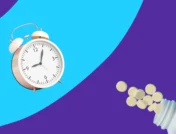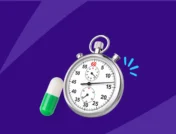Common amlodipine side effects | Serious side effects | Weight gain | Hair loss | Leg pain | Side effects timeline | Contraindications | Warnings | Interactions | How to avoid side effects | How to treat side effects
Amlodipine is a generic prescription drug that reduces high blood pressure in people diagnosed with hypertension. It’s also used to reduce chest pain (stable angina) in those with coronary heart disease. Amlodipine and its brand-name versions, Norvasc and Katerzia, are calcium channel blockers. They relax and widen blood vessels, allowing them to lower blood pressure and lower the incidence of chest pain.
Amlodipine is sometimes combined into a single tablet with other blood pressure or cholesterol drugs, such as atorvastatin. Amlodipine’s side effects are relatively mild and most people won’t have problems taking it. When they do, there are ways to prevent or manage adverse effects.
Common side effects of amlodipine
By far, amlodipine’s most common side effect is swelling of the hands, feet, and lower legs (peripheral edema), affecting about one in three patients. Another one in seven people will experience swelling elsewhere. Most other common side effects do not occur as frequently as swelling.
The most common side effects are:
- Swelling of the extremities
- Swelling
- Palpitations
- Flushing
- Fatigue
- Dizziness
- Nausea
- Stomach pain
- Skin rash
- Itching
- Muscle cramps
Serious side effects of amlodipine
The most serious side effects of amlodipine are:
- Worsening of chest pain
- Heart attack (particularly in people with coronary artery disease)
- Low blood pressure
- Liver damage
- Swelling of the pancreas
- Severe allergic reactions
Weight gain
Both weight gain and weight loss have been reported by people taking amlodipine, but the incidence of either side effect is less than one percent. In some cases, weight gain may be associated with fluid retention and swelling. If weight does change unintentionally while taking amlodipine, talk to a healthcare professional, especially if parts of the body are swelling.
Hair loss
While there are claims that amlodipine may cause hair loss, less than 0.1% of people taking amlodipine have experienced hair loss. Not only is that remarkably rare, but there is also a possibility that hair loss isn’t related to amlodipine. Keep in mind that amlodipine is frequently combined with other blood pressure medications. Some of these, such as ACE inhibitors and beta blockers, can cause hair loss.
Leg pain
Leg pain is not commonly associated with amlodipine. A small number of people—less than 2%—may experience muscle pain and muscle cramps as a side effect of amlodipine. These problems may affect the legs. More commonly, however, people may notice “heavy legs” due to swelling. This can be uncomfortable.
Stopping amlodipine
As with any drug taken to lower blood pressure, stopping amlodipine will cause blood pressure to rise. This is not a rebound effect. Instead, it will take about a week or more after amlodipine is stopped for blood pressure to reach baseline levels. Of course, baseline (untreated) blood pressure will probably be high, and that’s not good. If amlodipine is causing problems, get medical advice from a healthcare professional before quitting the drug. Another blood pressure medication may be required to keep blood pressure at healthy levels.
How soon do amlodipine side effects start?
Many side effects can appear shortly after treatment starts, including fatigue, dizziness, and nausea. Some side effects, such as flushing, itching, or swelling, could come on rapidly after the first dose. Other side effects, such as swelling of the extremities, are delayed and happen later in treatment.
How long do amlodipine side effects last?
Many of amlodipine’s mild side effects will get better as the body adjusts to the medicine, though some may not. If the side effects are caused by the drug, they should improve within a day or so of discontinuing it. However, some adverse effects, such as severe allergic reactions, may take a few days to get better.
What are the long-term side effects of amlodipine?
Amlodipine does not have side effects associated with long-term treatment. In fact, most people take amlodipine for months or years. Amlodipine also does not have side effects that persist for weeks or months after the drug has been stopped. The greatest risks involve the heart: heart problems caused or worsened by amlodipine, including heart attack, may have long-term and even lifelong consequences.
Amlodipine contraindications
A “contraindication” is any physical condition that makes a drug too risky to take. For amlodipine, the FDA states that amlodipine is only contraindicated in people who are allergic to the drug.
Pregnancy
Amlodipine is not contraindicated at any stage of pregnancy, but there isn’t enough research to know if it’s safe to take. Based on animal studies, there is no evidence that it causes birth defects or other problems, but it may increase the risk of fetal death. As with many drugs, the FDA recommends that the prescriber and mother carefully weigh the benefits and risks when making a treatment decision.
Breastfeeding
Amlodipine is considered safe for breastfeeding mothers. Although amlodipine does pass into breast milk, it does so in low amounts. Amlodipine levels are undetectable in nursing babies and no problems have been reported to date.
Children
The FDA considers amlodipine to be safe and effective in children between the ages of 6 and 17 years.
Older adults
There is no evidence that amlodipine behaves differently in seniors than in younger adults. Though not prohibited, amlodipine is usually started at lower doses for people of advanced age.
Amlodipine warnings
Amlodipine has relatively few and mild side effects, so there aren’t many cautions or warnings.
Cautions
Like other prescription drugs, amlodipine can worsen certain medical conditions. It’s not contraindicated for those conditions, but healthcare providers will watch carefully to make sure they don’t get worse. These conditions include:
- Severe coronary artery disease (CAD)
- Narrowing of a heart valve (aortic stenosis)
Additionally, people with liver disease have a greater risk of side effects when using amlodipine.
Abuse and dependence
Amlodipine is not associated with recreational use or abuse. It is not known to cause physical dependence or withdrawal symptoms when discontinued.
Overdose
The maximum daily dose of amlodipine is 10 mg. An overdose of amlodipine could cause seriously low blood pressure and rapid heart rate. Call a poison control center or visit an emergency room when an overdose is suspected. Look for signs of an overdose, such as redness or warmth in the feet, lower legs, hands, and face. Fast heartbeats and fainting are signs that blood pressure is getting too low.
Recalls
Amlodipine recalls are limited to individual manufacturers who have had quality problems with amlodipine combination drugs. These recalls have been rare and temporary.
Amlodipine interactions
As a comparatively mild prescription drug, amlodipine only has a few drug interactions that may cause problems. Most drug interactions involve amlodipine affecting the body’s metabolism of other drugs or vice versa. Some drugs slow down the body’s breakdown of amlodipine, making side effects more likely. Some drugs speed up that process, making amlodipine less effective. On the other hand, amlodipine can slow down the metabolism of some other drugs, making side effects from those drugs more likely. None of these drugs are prohibited, but doses may need adjustment.
Although the effect isn’t great, there’s an increased risk of side effects when amlodipine is taken with:
- Macrolide antibiotics (particularly clarithromycin and erythromycin)
- Benzodiazepines
- Opioids
- Statins (particularly simvastatin)
- Immune suppressants such as tacrolimus and cyclosporine
- Some antiviral drugs (including most HIV/AIDS and hepatitis C antiviral medications)
- Some antifungal medications such as ketoconazole or itraconazole
- Anticonvulsants
- Supplements such as St. John’s wort
- Grapefruit or grapefruit juice
Simvastatin will be limited to 20 mg per day in people taking amlodipine.
In addition, amlodipine can increase the risk of heart problems when combined with medications that treat irregular heartbeats or other calcium channel blockers, such as diltiazem and verapamil.
Keep in mind that some drugs lower blood pressure and some raise blood pressure. When amlodipine is combined with drugs that lower blood pressure, there may be problems with low blood pressure:
- Blood pressure medications
- Angina medications
- Sedatives
- Tricyclic antidepressants
- Muscle relaxants
- Erectile dysfunction medications
- Alcohol
When amlodipine is combined with drugs that raise blood pressure, the conflict neutralizes many of the benefits of taking amlodipine:
- Decongestants
- Stimulants
- Corticosteroids
- Migraine drugs
- ADHD medications
- Sympathomimetic drugs such as epinephrine
- NSAIDs
The antidepressant Marplan (isocarboxazid) is never prescribed with blood pressure drugs.
How to avoid amlodipine side effects
Amlodipine has few and often minimal side effects. This doesn’t mean that they don’t happen, so a few tips can help prevent problems or minimize side effects when they do occur.
1. Tell the prescriber about all medical conditions
When being examined by a healthcare professional, make sure they have a complete medical history. They need to know about medical conditions that may be worsened by amlodipine, especially:
- Heart valve problems
- Coronary artery disease
- Liver problems
- Pregnancy or any pregnancy plans
2. Share a list of all drugs being taken with the prescriber
Other medications that are being taken are also important. Include everything: prescription drugs, over-the-counter medications, and dietary supplements. The most important are:
- Other blood pressure medications
- Chest pain medications (nitroglycerin)
- Simvastatin
- Cyclosporine
- Tacrolimus
3. Take amlodipine as directed
Follow all the directions on the prescription label or given by the prescriber. If a dose is missed, take it as soon as it’s remembered. If it’s almost time for the next dose, though, skip the missed dose and take the next dose on time. Never take larger doses than prescribed for any reason.
4. Move carefully
Dizziness, tiredness, and drowsiness are not very commonly experienced by people taking amlodipine, but they can happen. By themselves, these side effects aren’t health-threatening problems, but falls and accidents caused by them are. Dizziness can be prevented by standing up slowly from a sitting or lying position. Make slow and careful movements, especially when bending down or getting up. It’s also smart to remove obstacles around the house that can be tripped over or fallen into.
5. Drink fluids
To help prevent low blood pressure, drink plenty of fluids throughout the day. Stay away from laxatives or other drugs that may cause dehydration.
6. Avoid aspirin and ibuprofen
Popular pain relievers called nonsteroidal anti-inflammatory drugs (NSAIDs) can harm the kidneys when taken with amlodipine. They also can raise blood pressure a bit. Acetaminophen can be substituted, but ask for medical advice first.
How to treat side effects of amlodipine
Although most people won’t have problems when taking amlodipine, there are ways to manage possible side effects when they do happen.
Dizziness
If feeling dizzy, sit down to prevent falling. Let the dizziness pass before attempting to get up. Avoid lying down because it might make the spinning or lightheadedness worse.
Redness
Amlodipine can cause blood vessels in the hands, feet, and face to widen, resulting in skin redness and warmth. If these side effects persist, a healthcare provider can prescribe a drug that will tighten blood vessels. If it continues too long, amlodipine may need to be replaced by another blood pressure drug.
Low blood pressure
Stay alert for signs that blood pressure is too low. These symptoms include lightheadedness, dizziness, feeling tired, and fainting. If an at-home blood pressure cuff is available, take a blood pressure reading. If not, contact a healthcare provider for medical advice.
Chest pain
When taking amlodipine for chest pain, it may take a couple of weeks to see substantial improvement. However, chest pain may worsen in some cases. If chest pain gets worse or doesn’t go away after a few minutes, get immediate medical attention.
Allergic reactions
When using amlodipine, watch for signs of an allergic reaction to the drug: shortness of breath, wheezing, trouble breathing, facial swelling, mouth swelling, severe skin rash, hives, or blisters. Immediate medical attention should be sought. After the reaction is resolved, amlodipine should be discontinued.
Sources
- Amlodipine, Drugs and Lactation Database
- Amlodipine, Epocrates
- Amlodipine besylate drug summary, Prescriber’s Digital Reference
- Amlodipine besylate tablet prescribing information, U.S. National Library of Medicine
- Amlodipine besylate tablet prescribing information (Greenstone), U.S. National Library of Medicine
- Drug Recalls, Food and Drug Administration (FDA)
- Pharmacokinetics and pharmacodynamics of amlodipine, Cardiology
- Severe neuromuscular complications possibly associated with amlodipine, Annals of Pharmacotherapy
- Vertigo, StatPearls











